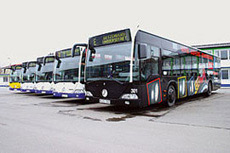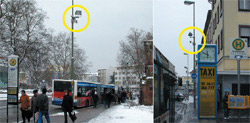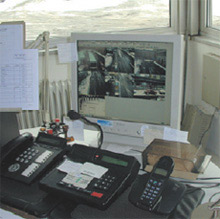Comprehensive network
The city of Kaiserslautern is committed to serving the needs of its citizens. This is reflected in the wide network of public transportation the city operates: 13 day bus and six night bus lines as well as approximately 450 bus stops throughout the city make sure that the 105,000 inhabitants of the German metropolis can get conveniently from A to B, around 13 million passengers use the services of the TWK Verkehrs-AG each year. This traffic company, a division of the "Technische Werke Kaiserslautern GmbH" (TWK), a modern utilities company tha provides the city with power, district heating, water and public transportation.
A century on wheels
In the summer of 2005, the public transportation system in Kaiserslautern celebrated its 100th anniversary. At an industrial exhibition in Kaiserslautern in 1905, Christian Fuchs, a hired coachman decided to buy a horse-drawn omnibus in Munich. He used it to start a lucrative business transporting exhibition visitors from the train station to the exhibition and back again for 10 pfennigs per passenger and trip.
Today, there are 58 vehicles in total, serving the citizens of Kaiserslautern. 115 drivers operate the vehicles and everything is coordinated by seven traffic managers. Another 36 employees work in administration at the Westphalian Public Transportation Services (WNS - Westphälische Nahverkehrs-Service GmbH), a subsidiary of TWK Verkehrs-AG that services the buses.

Good connections
Kaiserslautern has a star-shaped public transportation network. All the bus lines begin and end in the city centre at the "Rathaus" and "Schillerplatz" bus terminals, which are only a few meters apart. As a result, these central bus terminals are the main transfer point for the passengers. In the traffic management control centre, which is about two kilometres away, the traffic managers are not only responsible for making sure that all the buses are up and running on schedule, but they also have to ensure that each and every passenger makes the connection to the next bus.
"Of course, that is not possible unless the traffic managers on duty have a direct physical view of the current situation," commented Boris Flesch, division manager at TWK Verkehrs-AG and managing director of the WNS. All Kaiserslautern buses now have numbers on their roofs, so that they can be identified and recorded by the cameras mounted on the lampposts. Thanks to the transmission of the live images, the traffic managers have all the information they need about the current situation at any given time. If one bus is late, for example, the bus driver of the connecting line can be radioed and asked to wait for the connecting passengers.
 Optimizing the system
Optimizing the system
This system originally used analogue cameras. "But, that technology was really not optimal," recalled the division manager. "The cameras often didn't work properly because of line problems. The data volume was too high, the frame rate too low, the quality less than satisfactory, these problems hindered the work of the traffic managers."
When the company began to think about upgrading their camera system they looked for an IP based solution. They decided to install the weatherproof MOBOTIX camera system complete with on board software and Day /Night functionality at the central bus terminals.
Problem-free conversion
"Converting the system went off without any problems," reported Thorsten Moßmann, who, as an employee of K-net Telekommunikation GmbH, was responsible for the realization of the project. K-net is a 70%-owned subsidiary of the Technische Werke Kaiserslautern and also serves the community as a network operator. "We were able to use the copper wiring that was already installed for digital transmission," explained Moßmann. "All we had to do was to remove the old cameras and the analogue-digital converters and connect the new cameras. The image signals now all come to a central switch and are then forwarded via the fibreglass cable using municipal ethernet to the traffic management centre. That's where the file server is that stores the image data."
 Security for sculpture
Security for sculpture
Two other MOBOTIX camera systems keep a watchful eye on the "11-Friends" monument at the Fritz-Walter soccer Stadium as well as on another valuable sculpture in front of the TWK office. They have been installed to prevent vandalism and, should it occur, to help identify the culprits. These cameras use event- recognition along with the integrated recording and alarm management provided by MOBOTIX technology. "We don't want to use these cameras to monitor people in general; all we want to do is to protect our property," explained Boris Flesch.
Now that the system has been in operation for more than 12 months, it is natural to ask if the investment was worth it. "Thanks to the MOBOTIX cameras, our employees in the control centre have a very good, and, a very reliable overview of the current situation at both main bus stops," answered the managing director. "As a result, we are much better able to effectively control bus traffic and make sure that everything runs smoothly. These cameras have helped us to accomplish exactly what we wanted to accomplish."
Other applications
Thanks to the success of the installation and the concept of easy operation for the solution, the top managers at the TWK Verkehrs-AG have already begun to think about other applications. Boris Flesch enthused, " I can also well imagine using this technology to survey the main work yard."












